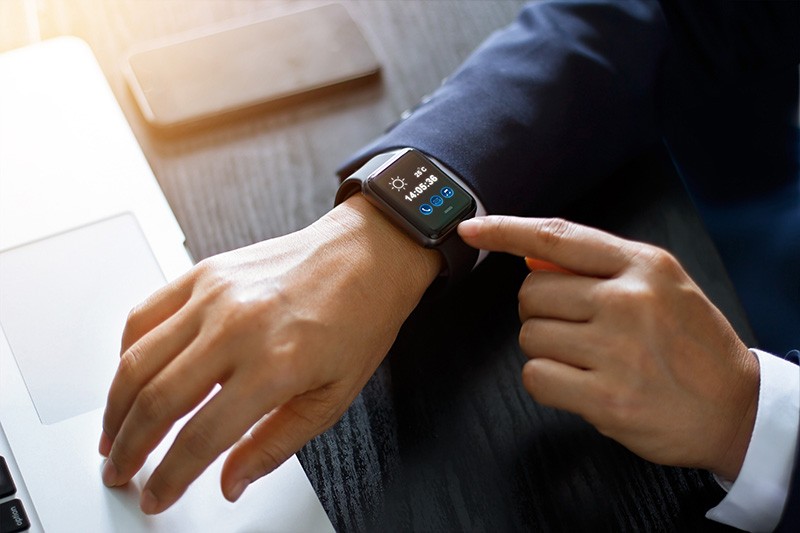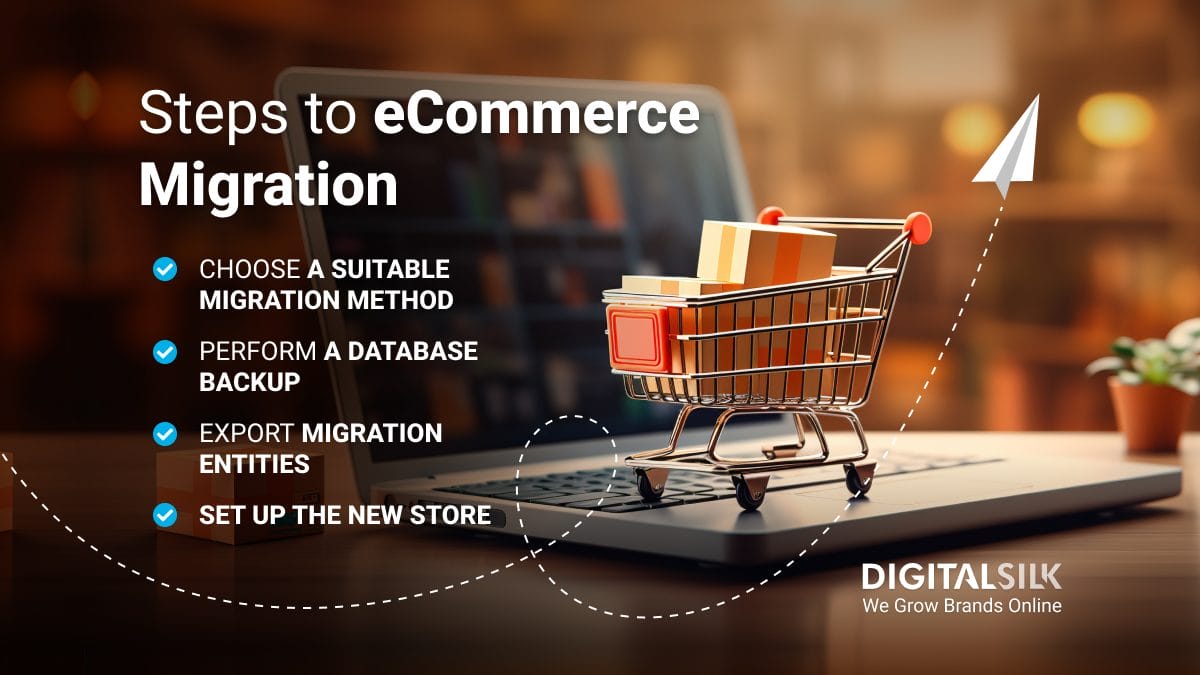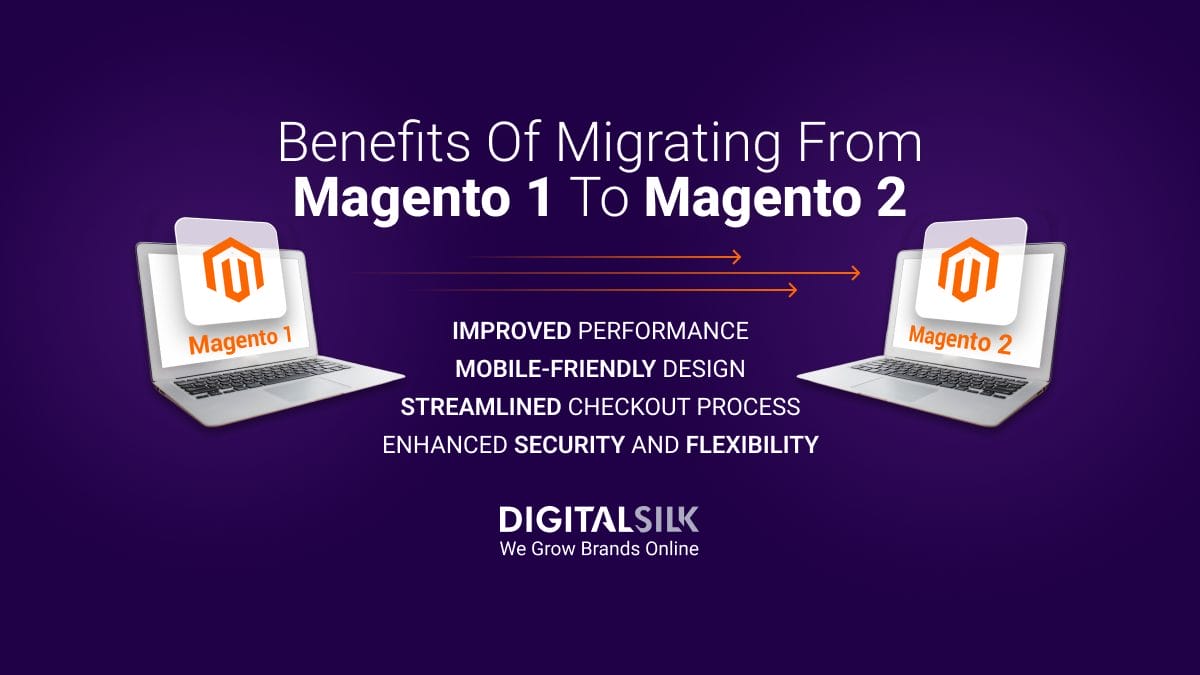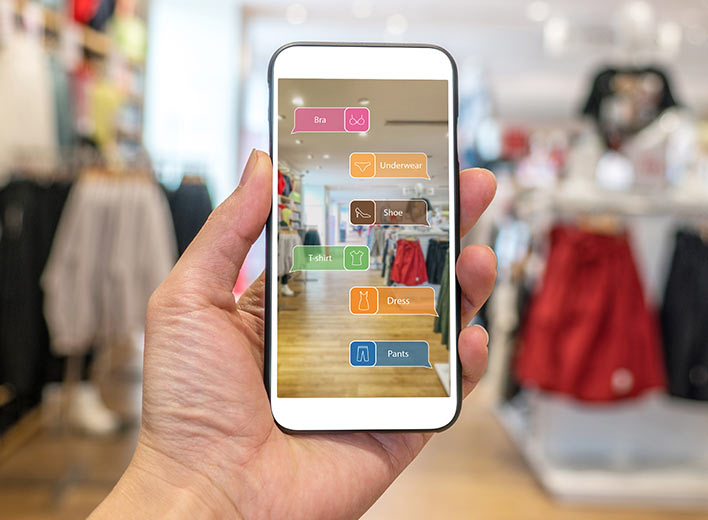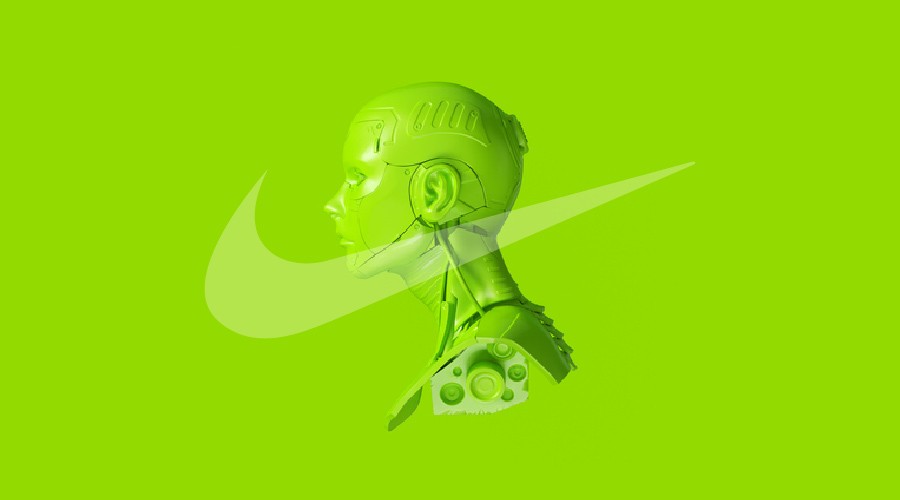The total number of connected wearable devices worldwide is expected to exceed 1.1 billion by 2022.
Wearable technology in business is revolutionizing workforce automation, from smartwatches to virtual reality (VR) headsets.
Wearables can help businesses overcome challenges in areas of employee policy, customers and assets.
But what exactly are the benefits and advantages of wearable tech, both for ordinary consumers and for businesses? How do companies put it to use and which businesses are leading the pack in this race?
In this article, we’ll answer those questions and more, while breaking down everything you need to know about wearable technology in business.
Digital Silk offers custom proposals. Request a quote
Why Wearable Technology In Business Matters
Research conducted by Salesforce reports the following impact of wearables on businesses:
- 79% of companies who have adopted wearable technology in business say that it is instrumental to their success
- 76% say that wearables improved their performance
- 86% claim they will increase their investment in wearables
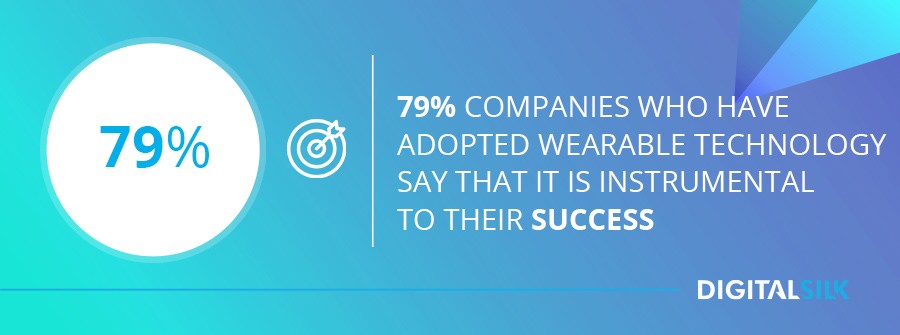
Not bad for a segment that was seen almost solely, until recently, as a playground for sci-fi aficionados.
Today, wearables are scattered across the spectrum of both the consumer market and business settings and the ways in which these overlap and influence each other continue to grow.
Let’s take a look at some real-life use cases of wearables and dive into how they create market demand.
Meet our expert developers. Set Up A Consultation
Types Of Wearables In Business
A study by Ericsson detailed consumer outlook on wearables that will influence the way businesses and enterprises view it as well.
Here are some of its findings:
- Two in five users of wearables say they feel naked when not wearing their device and a quarter of them even sleep with it on
- 43% of those surveyed believe smartphones will be replaced by wearables
- 40% of smartwatch users already interact less with smartphones, thanks to their wearable devices
- 70% said they believe wearable tech developers genuinely care about protecting user data
- 25% of wearable tech consumers feel that their expectations have not been met, although the general sentiment toward the future of wearables is positive
The wearables market is largely dominated by smartwatches and health/fitness activity trackers, although the amount of use cases is gradually expanding.
Let’s look at the most common wearable technology product types that are changing the game of the consumer market – and, consequently, of entire businesses.
1. Smartwatches
Smartwatches were originally associated with tracking and monitoring physical fitness (there is an entire health and fitness wearable app category derived from this).
However, their use has broadened since. Now they are mini-computers that can receive your emails, play multimedia and games, transfer files and even act as smartphones.
Hugely commercialized and usable across the spectrum, smartwatches possess a wide array of applications that make them an ideal candidate for workplace assistance and business incorporation.
2. Health/Fitness Trackers
Fitness trackers are pretty self-explanatory – they monitor heart rate, blood pressure, calorie consumption, distance walked and other indicators of one’s state of health.
These wearables can be strapped around the wrist or thigh, worn attached to clothing or on an armband and even implemented in running shoes with sensors via GPS tracking.
Fitness trackers can be synchronized with mobile apps in order to measure data more precisely so that individuals using them can be certain they are getting accurate readings.
Even though life-saving technology like pacemakers have long been a staple of medicine, even more high-tech prosthetics and embedded electronic monitoring devices are becoming a regular part of healthcare and medicine.
This wearable health tech, along with the apps, can assist in diagnosing health conditions and even how severe they are.
Some of the most advanced and sophisticated devices of this kind can even trace health signals such as the release of certain biochemicals.
3. Internet Of Things
The Internet of Things is one of the most promising niches for wearables.
Basically, it is adding the abilities of wearables, artificial intelligence and machine learning to everyday items people use in households, such as security cameras, lights, kitchen appliances and cooling systems.
All of these things are provided access to the internet through a network of wireless sensors and automation, creating the so-called concept of a “smart home.”
A smart home is a living space in which human intervention for adjusting the home to optimal conditions is minimal.
Google Home, Amazon Echo and Alexa are some of examples of these types of devices.
Use Cases For Wearables In Business
Now that we’ve explored the most common types of wearables, let us look at a couple of use cases for wearables in business.
1. Education
The possibilities of using wearables in education are huge.
Businesses that wish to provide their own signature product in this field have the chance to benefit schools and universities in a big way.
The adoption of knowledge through the use of smart glasses and VR headsets can significantly improve the way teachers and professors hold their lectures.
These can be broadened to also provide virtual class trips to historically significant places.
Even low-budget education institutions could afford these wearables that can provide the levels and dimensions of education that would normally require a much bigger investment.
2. Public Service
Professional and public services such as police and firefighters use wearable technology to help alleviate some of the risks of their daily working routine and help them do their job to the best of their ability.
Wearable tech like smart glasses and smartwatches can alert first responders of impending dangers and provide insight into their general state and the state of their surroundings.
Another example of wearables use in public service is the body cameras worn by law enforcement officers. They have proven themselves effective in documenting the officer’s actions and providing additional video evidence from crime scenes.
Benefits of Wearable Technology in Businesses
Wearables can benefit your business in several important ways:
1. Boost Of Employee Productivity
Wearables are able to boost employee productivity by trimming down non-value activity and enabling workers to fully focus on the job they are qualified for, which is vital to good time management for every company.
2. Improved Communication
Technology such as smartwatches enables push notifications and other means of being timely informed of an important update, along with an option of responding to it.
Such responsiveness not only strengthens communication between individual employees and work sectors, it also increases job satisfaction in workforce professions.
3. Safety
Wearable technology in business drives health and safety in the workplace and mitigates accidents, as Liberty Mutual Insurance explains.
There are certain working sectors, such as warehouses, construction and manufacturing that have a greater risk of injuries on the job than others, and many of these sectors are using wearables as a prevention method.
Fitness trackers and smart clothing with implemented sensors can assist workers in the following ways:
- Identify potential injuries and risk factors by monitoring body positioning and posture
- Alert the worker on their level of fatigue and of risks that could lead to accidents
- Alert the worker when the surroundings have become potentially hazardous (too noisy, heated or toxic)
- Stop heavy machinery in case of emergency
4. Improved Customer Service
Wearables have the capability to impact customer service and customer satisfaction.
According to CustomerThink, By collecting personal information such as biometric data, location, info on spending and buying history and so on, “retailers will be able to connect the dots between pre-store and in-store behavior.”
With this information, stores can alter their processes based on the way customers interact and pay for their purchases.
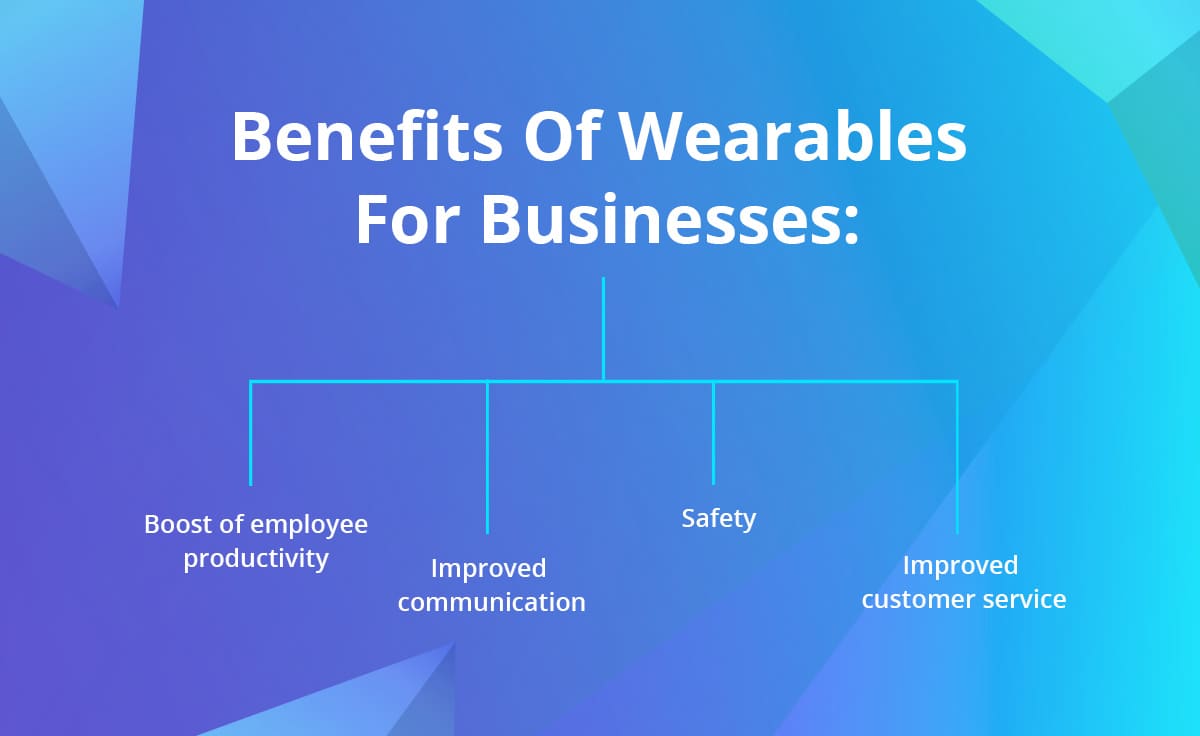
How To Maximize Wearables’ Business Benefits
To reap the benefits of implementing wearable technology in your workplace, you should take the following steps:
1. Identify Gaps To Bridge
Wearable technology in business is arguably still a young and enticing industry.
It may be too easy to get caught up in simply hopping on board and choosing a general type of wearable for your workforce. However, it’s important to identify the right gaps and find the fitting solutions to bridge them.
2. Conduct Research
After your company has identified its greatest weaknesses and issues that can be alleviated with wearables, it’s time to do your research.
Look at different types of wearables and identify which one will make the most impact and be the most beneficial for your employees and for your business.
3. Train Employees
No matter how effective the wearable tech may be, it won’t be much good if it’s not used properly.
Be sure to t educate your employees, explain why the company is implementing wearables and how the changes will benefit them.
After the wearables are implemented, be sure to gather employee feedback as well.
4. Understand Objectives & Measure Success
It’s important to understand what exactly you’re trying to achieve with wearables.
Measure the state of your workplace before and after putting wearables to use, and weigh the results to get an accurate depiction of how the process has affected the company and its employees.
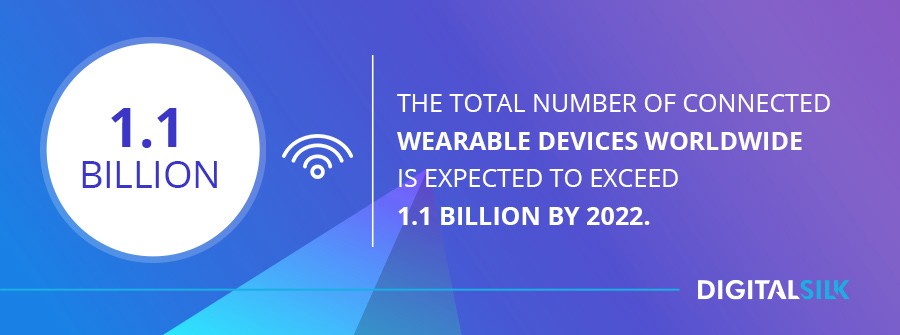
How Wearables Impact Employee Productivity: Trends To Anticipate
Across various industries, the use of wearable tech in companies is still in its growing phases.
The aforementioned Salesforce study holds that in terms of use cases:
- 23% of companies use wearables for workplace security
- 20% of companies use them for employee time management
- 20% use them for communication among employees
If they’re not building wearable tech and wearable apps themselves, adopter companies are encouraging employees to bring their own wearables to work.
The “Bring Your Own Wearables” initiative is becoming a widespread phenomenon across companies.
54% of companies support this model, while 40% of those questioned plan to do so in the future.
Servicefutures observes that workplaces of today are getting increasingly diverse – and, while that in itself is a positive trend, the variety of different generations and profiles all have differing, sometimes mutually exclusive ideas on how a workplace should be.
This concerns wearables in a big way. What is a helpful, sophisticated widget to increase work productivity for some, may be an intrusion of privacy for others.
Businesses should not, therefore, insist on a one-size-fits-all policy but evaluate the context of every wearable amenity for each employee.
Wearable technology in business can further improve workspace conditions through the detection of stress and even the cause behind it.
Human resources departments can use wearables to identify the ways in which employees spend their time in certain parts of the company and how to change their experience for the better.
How Wearables Impact User Experience
As customers get increasingly used to the idea of sharing wearables data with enterprises, the companies can branch into more experimental uses.
Some of the customer functions of wearable tech include reward programs, point of sale and integrated shopping experience – according to Salesforce research.
Consumers that use wearables usually begin with more traditional, first-base use cases that are tied with programs such as loyalty or point of sale.
However, as a new wave of innovation is expected to spread in the next two years or so, with businesses trying out new ways of connecting with their customers, more immersive experiences will become available.
The biggest growth, in terms of customer interaction with wearables and companies using them, is expected in:
- Device integration
- Immersive experiences
- Location-sensing tech
It’s worth noting that a triple growth rate is a forecast for immersive experiences and location-sensing technology.
We will see a 3x growth rate in areas like immersive experiences and location-sensing technology, showing an intent to improve customer touchpoints with 1:1 interactions.
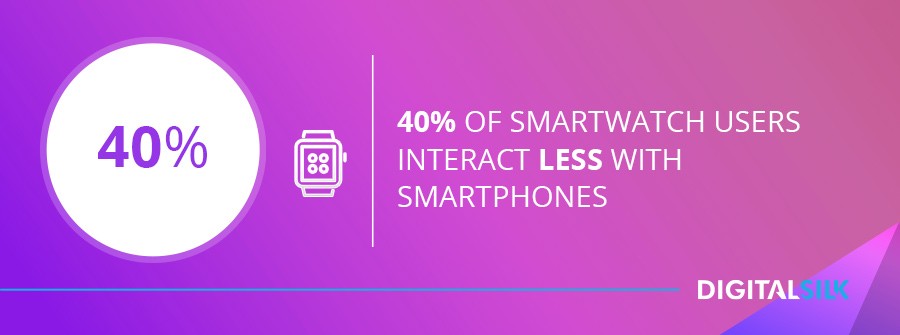
Top 5 Wearable Tech Devices That Have Transformed Businesses
Here is our selection of the top five wearable devices that have the potential to completely transform your business:
1. Theatro
Theatro is using artificial intelligence and voice and language recognition systems to unlock the potential of business productivity.
Its Internet of Things intelligence assistant gives way to collaboration apps and a company’s enterprise apps.
Employees are interconnected as well as connected to the enterprise’s information, which puts them in a position to deliver superior customer experiences.
Claiming that the usage of mobile phones in the retail workplace as a means of enhancing productivity has failed, Theatro claims to have reinvented the mobile revolution for millions of employees.
Thus the IoT system empowers employees (by giving them tools to meet customer expeditions), connects people and systems (by giving employees access to the right information) and improves productivity (making employees “heads-up” and “hands-free”), creating new insights and driving profits.
2. TaskWatch
As per the official site statement, “TaskWatch keeps employees mobile, handsfree and connected to enterprise systems.”
It enhances workplace productivity through wearable workflow and “transforms information into measurable and actionable tasks.”
This hands-free mobility for enterprises requires no code when deploying mobile process applications and integrates with enterprise systems.
This smartwatch-like device enhances enterprise productivity while keeping employees mobile and connected through customizable notifications.
Lastly, the gamification feature is added for boosting employee engagement and motivation and enhancing business efficiency and VIP customer experience.
3. Notable
This digital assistant, used in healthcare, streamlines and transforms workflow processes for continued care, thus enabling a superior consumer experience.
Notable’s artificial intelligence wearable platform improves data accuracy and patient interaction.
Essentially putting the healthcare administration on auto-pilot, it collects and transfers data in a more sustainable way, with less expenditure and waste.
Notable’s CEO and co-founder, Pranay Kapadia, said of this wearable device:
“We designed Notable Health’s technology to act as an ‘autopilot’ that uses sophisticated AI to learn physician behaviors and patterns. This allows physicians to focus fully on patients rather than on manual documentation, resulting in overall better patient experience.”
4. Carnival’s Ocean Medallion
Carnival’s Ocean Medallion is a wearable tech that is helping engage customers and enhance their experience, as well as increase revenue for businesses.
This small wearable is a token that can be worn on a chain or a wristband and is given to passengers that board the cruise ship.
They can work as smartphones or credit cards. The token is used to check-in and pay for products and services.
This wearable is based on the Internet of Things – the token alerts the staff when a customer is near the venue where the purchase will be made so that they can prepare.
For instance, in a restaurant, employees can anticipate a customer’s arrival and provide a personal meeting and prepare a table for them in advance if they have preordered a meal.
Housekeepers are also immediately notified when passengers leave their cabin so they can enter it and make it tidy again, without disturbing anyone.
5. Amazon Mayday
Amazon’s Mayday is a revolutionary live tech support tool for the e-book tablet device Kindle.
CEO Jeff Bezos once described it as “having someone standing right next to you and providing tech support.”
It allows a user to see the remote person from tech support in a small window.
It also displays the user’s screen on the support person’s screen, so they can see the issue directly, annotate the screen and take command of the interface.
Amazon’s headquarters in Seattle contains the full infrastructure that supports Mayday.
The objective is to have 15-second responsive times and to enhance the support services around holidays like Christmas when sales of Kindle are boosted.
Takeaways From Wearable Technology In Business
Wearable devices can benefit your business in multiple ways. Here are a few reasons why you should consider implementing them in your workplace:
1. The Wearables Market Will Continue To Grow
There is a massive, yet unexplored potential of wearables in the global market that is not even in full swing.
This segment is capable of pushing the envelope of everyday living and business like no other before.
Wearable tech is an interesting ground for innovators and inventors. Investing in such a promising segment, that is still in its infancy, has become a widespread notion.
2. It’s Trendy
Companies and businesses that deploy wearable technology and embed it into their workplace attain a reputation for being trendy.
The inventive nature of this technology assures there are myriad ways to use it, all for a different benefit.
“Wearing internet” is something that sounds appealing to most and the enhanced user experience is what makes this different from any other current trend.
Companies that got on board with wearables before they became the norm will likely always have an edge over competitors.
3. They Solve Real Problems
Employees, managers, decision-makers and even the general population stand to gain a lot from using wearable technology.
We already evidenced that health and safety sectors, in particular, can take pride in addressing real-life issues through these devices.
Substantial matters of increasing work productivity and efficiency, bridging the gaps of expenditure, even saving lives and eliminating tragic outcomes – these are problems people encounter on a regular basis, significantly softened through wearable apps.
4. They Lead To Further Innovations
Potentially, the market of wearable technology in business is inexhaustible: the world just scratched the surface of this huge potential segment and the opportunities seem vast.
There is a watershed of possibilities and directions to take so that forward-thinking companies can truly partake in reshaping the workplace and translating it into the future.
"*" indicates required fields


